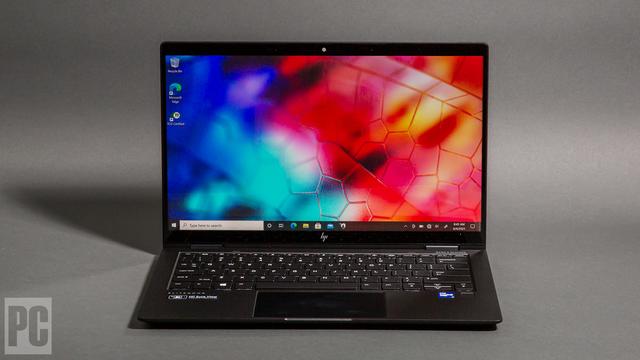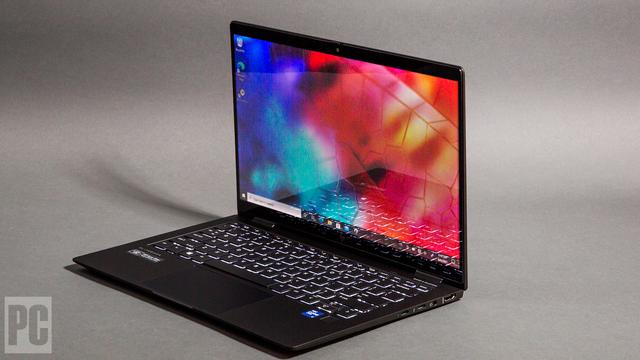
HP Elite Dragonfly Max Review
Vaccines have provided light at the end of the tunnel, but the HP Elite Dragonfly Max (starts at $2,239; $2,789 as tested) may be the official laptop of the pandemic. Not only is this 13.3-inch convertible rated to survive 1,000 rubdowns with household wipes (an HP Easy Clean utility temporarily locks the keyboard and touchpad while you scrub), but it's created for Zoom meetings and other online collaboration. Its 5-megapixel webcam is far superior to most notebooks' cheap 720p cameras, and it sports no fewer than four microphones backed by AI noise cancellation. Plus, you get 5G mobile broadband, as well as support for Wi-Fi 6. Remote teams and soon-again frequent fliers will be tempted, but the Dragonfly Max, while attractive, is much too expensive for the business mainstream.
A Second Second Generation
The original Elite Dragonfly copped a PCMag Editors' Choice award in December 2019 for its light weight, top-quality construction, and LTE connectivity. Today, HP has split the line in two, with an Elite Dragonfly G2 joined by the Elite Dragonfly Max—a "purpose-built premium PC for professional collaborators," to quote the company's marketing.
Our Experts Have Tested 131 Products in the Laptops Category in the Past YearSince 1982, PCMag has tested and rated thousands of products to help you make better buying decisions. (See how we test.)(Photo: Molly Flores)Both the $2,239 base model (Intel Core i7-1165G7, no LTE) and our $2,789 test unit (Core i7-1185G7, Qualcomm Snapdragon X55 5G cellular data) feature a sleek Sparkling Black magnesium shell, a full HD touch screen with HP's Sure View Reflect privacy filter (to stop airline seatmates from spying your sensitive data), 16GB of RAM, a 512GB NVMe solid-state drive, Windows 10 Pro, and a three-year warranty.
Those are admirable specifications, but they command formidable price tags. Among 13.3-inch convertibles, the Editors' Choice-winning Dell XPS 13 2-in-1, the Lenovo ThinkPad X13 Yoga, the Asus ZenBook Flip S, and the HP Spectre x360 13 were all under $1,500 as tested. The Asus even had a 4K OLED display.
4.5Outstanding$1,669.00See Itat Dell TechnologiesRead Our Dell XPS 13 2-in-1 (9310) Review 4.0Excellent$1,559.00See Itat DellRead Our Dell Latitude 7320 2-in-1 Review 4.0Excellent$962.49See Itat HPRead Our HP Spectre x360 13 (2021) Review 4.0ExcellentRead Our MSI Summit E13 Flip Evo Review 3.5Good$1,587.39See Itat AmazonRead Our Asus ZenBook Flip S (UX371) Review 3.5Good$1,379.99Check Stockat AmazonRead Our Lenovo ThinkPad X13 Yoga (Gen 1) Review(Photo: Molly Flores)Even super-deluxe business 2-in-1 models like Dell's Latitude 7320 and Lenovo's ThinkPad X1 Yoga and X1 Titanium Yoga cost less than the Elite Dragonfly Max. I haven't read any other reviews of the HP as I write this, but I suspect my colleagues and I are all going to say the same thing—that you can save a bundle by buying a less costly convertible and a top-of-the-line USB webcam.
Still, the Max has several points in its favor. Its use of magnesium makes it strong enough to pass MIL-STD 810H durability tests, yet it is lighter at 2.49 pounds than most rivals. (The XPS 13 2-in-1 weighs 2.9 pounds, and the Spectre x360 13 is 2.8 pounds.) The system measures 0.63 by 12 by 7.8 inches, not far from the Dell's 0.56 by 11.7 by 8.2 inches and the Spectre's 0.67 by 12.1 by 7.7 inches.
(Photo: Molly Flores)The compact AC adapter plugs into one of two USB4 Type-C ports with Thunderbolt 4 functionality on the system's right edge, which also holds an audio jack and an HDMI video output. One USB 3.1 Type-A port joins a security lock slot, a nano SIM slot, and the power button at left.
Restricted-View Seating
Since it's all about collaboration, I was mildly surprised that the Elite Dragonfly Max doesn't have the shortcut keys to place and end video calls found on some HP EliteBook (and Lenovo ThinkPad) keyboards. And, for that matter, I missed the webcam toggle key found on other premium HP laptops—the camera has a sliding privacy shutter in the top bezel. That's fine, but not a luxury solution.

The backlit keyboard does have a microphone mute key and a snappy typing feel, although the Escape and Delete keys are puny and the cursor arrow keys are arranged in HP's toxic trademark row—with half-height up and down arrows stacked between full-size left and right—instead of the correct inverted T. The buttonless touchpad glides and taps easily, with a slightly heavy click.
(Photo: Molly Flores)While the Elite Dragonfly G2 offers a choice of 1080p or 4K resolution displays, the Max's only screen is a 1080p touch panel with HP's Sure View Reflect, which at a touch of the F2 key makes the display opaque to anyone not positioned directly in front of it.
I disliked the first couple of generations of Sure View screens for being unreadably dark in privacy mode, even when viewed from dead center. This one works better, though the mode still has a noticeable effect when on. Pressing F2 turns white backgrounds gray and makes colors look smothered, as if you'd turned the brightness all the way down. But you can still get work done.
In normal mode, backgrounds are nicely white and colors are rich, though they don't exactly pop. Contrast is adequate, and details are relatively sharp. Even when disabled, the privacy technology seems to swallow up about 700 of the rated 1,000 nits of brightness and makes viewing angles much narrower than normal for today's IPS screens, but it's no hardship.
(Photo: Molly Flores)The 2,560-by-1,440-pixel webcam blows away its 1,280-by-720-pixel competition with slightly noisy but well-lit, colorful, and ultra-sharp images. (If you were too lazy to shave before a morning meeting, your co-workers will know it.) Its face-recognition capability and a fingerprint reader on the palm rest give you two ways to skip typing passwords.
Four speakers (two top-firing, two bottom-firing) with discrete amplifiers produce loud and crisp sound. There's not a lot of bass, but audio is strong without echoing or booming, and you can make out overlapping tracks. To enhance the sound, HP Audio Control software lets you tinker with an equalizer with pop, rock, jazz, country, and other presets.
Other software aboard ranges from HP's malware-fighting Sure Click Browser and QuickDrop smartphone file transfer to WorkWell exercise reminders, Adobe creative trials, and the Bluetooth-based Tile location service.
Testing the Elite Dragonfly Max: Performance to the, Ahem, Max
The Elite Dragonfly Max's Core i7-1185G7 is a quad-core, 3.0GHz (4.8GHz turbo) processor with Intel's Iris Xe integrated graphics. For our benchmark charts, I pitted the HP against four comparably sized convertibles ranging from the consumer-oriented Asus ZenBook Flip S and Dell XPS 13 2-in-1 to the business-focused (and Core i5- rather than Core i7-powered) Dell Latitude 7320 2-in-1 and Lenovo ThinkPad X13 Yoga. You can see their basic specs in the table below.
PCMark 10 and 8 are holistic performance suites developed by the PC benchmark specialists at UL (formerly Futuremark). The PCMark 10 test we run simulates different real-world productivity and content-creation workflows. We use it to assess overall system performance for office-centric tasks such as word processing, spreadsheet work, web browsing, and videoconferencing. PCMark 8, meanwhile, has a storage subtest that we use to assess the speed of the system's boot drive. Both yield a proprietary numeric score; higher numbers are better. (See more about how we test laptops.)
All except the Lenovo topped the 4,000 points in PCMark 10 that mean excellent productivity for Microsoft Office or Google Docs, with the HP leading the way. PCMark 8's storage exercise is pie for today's speedy SSDs.
Next is Maxon's CPU-crunching Cinebench R15 test, which is fully threaded to make use of all available processor cores and threads. Cinebench stresses the CPU rather than the GPU to render a complex image. The result is a proprietary score indicating a PC's suitability for processor-intensive workloads.
Cinebench is often a good predictor of our Handbrake video editing benchmark, in which we put a stopwatch on systems as they transcode a brief movie from 4K resolution down to 1080p. It, too, is a tough test for multi-core, multi-threaded CPUs; lower times are better.
The Max landed in the middle of the pack in these processing benchmarks. It's no workstation, but it's perfectly capable of taking on everyday tasks.
We also run a custom Adobe Photoshop image-editing benchmark. Using an early 2018 release of the Creative Cloud version of Photoshop, we apply a series of 10 complex filters and effects to a standard JPEG test image. We time each operation and add up the total (lower times are better). The Photoshop test stresses the CPU, storage subsystem, and RAM, but it can also take advantage of most GPUs to speed up the process of applying filters.
The HP, Asus, and Dell XPS breezed through our photo editing exercise, though serious image collectors will likely want a higher-resolution display and an SD card slot. The Yoga's 10th Generation Core i5 was out of its league.
We test Windows systems' relative graphics muscle with two gaming simulations, 3DMark and Superposition. The first has two DirectX 11 subtests, Sky Diver and Fire Strike, suitable for mainstream PCs with integrated graphics and higher-end gaming rigs respectively. The second uses the Unigine engine to render and pan through a detailed 3D scene at two resolution and image quality settings with results measured in frames per second (fps); 30fps is usually considered a fair target for smooth animation while avid gamers prefer 60fps or higher.
The Intel UHD integrated graphics of the Lenovo ThinkPad X13 Yoga are no match for the newer Iris Xe silicon of the others, but none of the five is a match for a gaming laptop with a discrete GPU. They're strictly for casual and browser-based games and streaming video, not demanding 3D shoot-em-ups.
After fully recharging the laptop, we set up the machine in power-save mode (as opposed to balanced or high-performance mode) where available and make a few other battery-conserving tweaks in preparation for our unplugged video rundown test. (We also turn Wi-Fi off, putting the laptop into airplane mode.) In this test, we loop a video—a locally stored 720p file of the Blender Foundation short film Tears of Steel—with screen brightness set at 50% and volume at 100% until the system quits.
The Max and XPS showed great stamina, while the ZenBook's high-res screen took its toll. Getting through a long workday plus a little after-hours Netflix should be no problem.
Verdict: The Max Levies a Painful Premium
If your work calls for connectivity in the field away from Wi-Fi hotspots, top-quality video calling, and a screen that keeps prying eyes away from your product plans or financials, the Elite Dragonfly Max is tailor-made for you.
(Photo: Molly Flores)Most business professionals, however, won't meet all three of those criteria and won't be able to justify the HP's steep price, particularly when the company's Editors' Choice award-winning Spectre x360 14 costs much less. If your budget can absorb the big hit, however, this model will keep unwelcome eyes off your data and keep you connected (and looking good on camera) better than most.
3.5See It$2,409.84 at HPBase Configuration Price $2,239.00View MoreHP's ultraportable Elite Dragonfly Max offers a tempting mix of 5G, a 5-megapixel webcam, and a security screen that thwarts nosy seatmates, but you'll pay an extra grand for the combo.
Sign up for Lab Report to get the latest reviews and top product advice delivered right to your inbox.
EmailThis newsletter may contain advertising, deals, or affiliate links. Subscribing to a newsletter indicates your consent to our Terms of Use and Privacy Policy. You may unsubscribe from the newsletters at any time.
Thanks for signing up!Your subscription has been confirmed. Keep an eye on your inbox!
}})